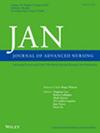中国护士同情能力的潜在特征分析
IF 3.4
3区 医学
Q1 NURSING
引用次数: 0
摘要
目的了解护士同情能力的现状,基于潜在剖面分析分析不同类别护士同情能力的特点及影响因素,为制定有针对性的同情培训方案提供理论依据。设计横断面研究。方法采用方便抽样的方法,于2023年6 - 10月选取山东省三级甲等医院550名护士,采用人口学特征问卷、护士同情心能力量表、正心注意意识量表和Maslach职业倦怠量表-人力服务问卷进行调查。采用潜在剖面分析探讨护士同情能力的潜在类别,采用单因素分析和logistic回归分析探讨相关影响因素。结果共纳入513名护士。护士的同情能力分为同情能力缺失组(7.56%)、同情能力低不平衡组(15.35%)、同情能力高平衡组(50.38%)和同情能力优秀组(26.70%)四类。科室、工作年限、人文关怀培训经历、工作是否得到同事和领导的支持、正念和工作倦怠是不同潜能类别的影响因素(均p < 0.05)。结论护士的同情胜任力可分为四类。护理管理者和医疗机构可以根据各类护士的特点,制定精准的培训方法,增强护士的同情心胜任力,从而提高护理服务质量。影响本研究结果有助于了解护士同情心能力的类别和异质性,为护理管理者和医疗机构提高不同类别护士的同情心能力提供依据。患者或公众贡献所有参与者均为护士,他们完成了与本研究相关的电子问卷。本文章由计算机程序翻译,如有差异,请以英文原文为准。
Profiles of Compassion Competence Among Nurses of China: A Latent Profile Analysis.
AIMS
To understand the current situation of nurses' compassion competence and analyse the characteristics and influencing factors of different categories of nurses' compassion competence based on latent profile analysis, to provide a theoretical basis for formulating targeted compassion training programmes.
DESIGN
A cross-sectional study.
METHODS
From June to October 2023, 550 nurses from tertiary grade A hospitals in Shandong province were selected by convenience sampling and investigated by utilising a demographic characteristics questionnaire, the Compassion Competence Scale for the Nurses, the Mindful Attention Awareness Scale and the Maslach Burnout Inventory-Human Service Survey. Latent profile analysis was performed to explore the potential categories of nurses' compassion competence, and single-factor analysis and logistic regression analysis were used to explore the related influencing factors.
RESULTS
A total of 513 nurses were included. The compassion competence of nurses could be divided into four categories: the compassion competence deficient group (7.56%), the compassion competence low-imbalanced group (15.35%), the compassion competence high-balanced group (50.38%) and the compassion competence excellent group (26.70%). Department, years of working, humanistic care training experience, whether work is supported by colleagues and leaders, mindfulness and job burnout were the influencing factors of different potential categories (all p < 0.05).
CONCLUSION
There are four categories into which nurses' compassion competency can be categorised. Nursing managers and medical institutions can formulate precise training methods that enhance nurses' compassion competency based on the traits of various nurse categories in order to improve the quality of nursing service.
IMPACT
The results of this study help to understand the categories and heterogeneity of nurses' compassion competence and provide a basis for nursing managers and medical institutions to improve the compassion competence of different categories of nurses.
PATIENT OR PUBLIC CONTRIBUTION
All participants were nurses who completed an electronic questionnaire related to this study.
求助全文
通过发布文献求助,成功后即可免费获取论文全文。
去求助
来源期刊
CiteScore
6.40
自引率
7.90%
发文量
369
审稿时长
3 months
期刊介绍:
The Journal of Advanced Nursing (JAN) contributes to the advancement of evidence-based nursing, midwifery and healthcare by disseminating high quality research and scholarship of contemporary relevance and with potential to advance knowledge for practice, education, management or policy.
All JAN papers are required to have a sound scientific, evidential, theoretical or philosophical base and to be critical, questioning and scholarly in approach. As an international journal, JAN promotes diversity of research and scholarship in terms of culture, paradigm and healthcare context. For JAN’s worldwide readership, authors are expected to make clear the wider international relevance of their work and to demonstrate sensitivity to cultural considerations and differences.

 求助内容:
求助内容: 应助结果提醒方式:
应助结果提醒方式:


